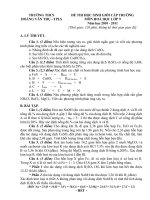- Trang chủ >>
- Văn Mẫu >>
- Văn Kể Chuyện
trường thcs hoàng xuân hãn
Bạn đang xem bản rút gọn của tài liệu. Xem và tải ngay bản đầy đủ của tài liệu tại đây (32.02 KB, 2 trang )
<span class='text_page_counter'>(1)</span><div class='page_container' data-page=1>
<b>BRITISH COLUMBIA SECONDARY SCHOOL</b>
<b>MATHEMATICS CONTEST, 2016</b>
<b>Senior Final, Part A</b>
<b>Friday, May 6</b>
1. If 10<i>x</i>=<i>m</i>, then 10<i>x</i>+2is equal to:
(A) <i>m</i>2 <sub>(B)</sub> <i><sub>m</sub></i><sub>+</sub><sub>100</sub> <sub>(C) 100</sub><i><sub>m</sub></i> <sub>(D)</sub> <i><sub>m</sub></i><sub>+</sub><sub>2</sub> <sub>(E) 2</sub><i><sub>m</sub></i>
2. There are five married couples in a room. Each person shakes hands with everyone else, but does not
shake hands with their own partner. How many handshakes happen?
(A) 10 (B) 15 (C) 24 (D) 40 (E) 45
3. A series of books was published at seven-year intervals. When the seventh book was issued, the sum
of the publication years was 13, 524. When was the first book published?
(A) 1911 (B) 1918 (C) 1932 (D) 1939 (E) 1953
4. Six points are equally spaced around a circle of radius 6. Three of the points are vertices of a triangle
that is neither equilateral nor isosceles. The area of the triangle is:
(A) 12<i>√</i>3 (B) 18<i>√</i>3 (C) 36 (D) 24<i>√</i>3 (E) 48
5. A circle of radius 17 intersects another circle, radius 22, at right
angles as shown. What is the difference of the areas of the
non-overlapping portions?
(A) 115<i>π</i> (B) 135<i>π</i> (C) 155<i>π</i>
(D) 175<i>π</i> (E) 195<i>π</i>
17 22
6. Professor Paul gave course marks based on an average of a series of tests. Before Suzanne’s last test
she realized that she would have to score 97% in order to average 90% for the course. On the other
hand, if she scored as low as 73% she would still be able to average 87%. How many tests were in
Professor Paul’s series?
(A) 7 (B) 8 (C) 9 (D) 10 (E) 11
7. For any positive integer<i>n</i>, define<i>n</i>!=1<i>·</i>2<i>·</i>3<i>· · ·</i>(n<i>−</i>1)<i>·n</i>. Consider the product
(
1
2
) (
3
4
) (
5
6
)
<i>· · ·</i>
(
2<i>n−</i>1
2<i>n</i>
)
where<i>n</i>is a positive integer. A general formula for this product for any positive integer<i>n</i>is:
(A) (2<i>n)</i>!
22<i>n</i><sub>(n</sub><sub>!</sub><sub>)</sub>2 (B)
2<i>n</i>!
2<i>n</i>+1<sub>(n</sub>2<sub>)</sub><sub>!</sub> (C)
(2<i>n)</i>!
2<i>n</i><sub>(n</sub><sub>!</sub><sub>)</sub>2
(D) 2<i>n</i>!
22<i>n</i><sub>(n</sub><sub>!</sub><sub>)</sub>2 (E)
</div>
<span class='text_page_counter'>(2)</span><div class='page_container' data-page=2>
<b>BC Secondary School</b>
<b>Mathematics Contest</b> <b>Senior Final, Part A, 2016</b> <b>Page 2</b>
8. The wheels of a car have six-way radial symmetry (see diagram)
and measure 0.75 m in diameter. A video camera which captures
12 frames per second creates a video of the car in motion. In the
video, the wheels of the car appear to be not turning at all. If
it is known that the car is traveling at a speed between 15 and
20 m/s, which of the following is a possible speed for the car,
measured in m/s?
(A) 4<i>π</i> (B) 15 (C) 18
(D) 6<i>π</i> (E) 24
0.75 m
9. A tetromino is a geometric shape formed by adjoining four squares with one another, edge to edge.
There are five distinct tetrominoes:
(1) (2) (3) (4) (5)
Shapes that can be obtained by rotating or reflecting one of these five tetrominoes are not considered
distinct tetrominoes. For example, the shape
is considered to be the same as (4) above because it is a reflection of (4).
A pentomino is formed by adjoining five squares with one another, edge to edge. How many distinct
pentominoes are there?
(A) 10 (B) 12 (C) 14 (D) 16 (E) 18
10. 70% of the adult males of a community have brown eyes, 75% have dark hair, 85% are over six feet tall,
and 90% weigh more than 140 pounds. What is the minimum percentage of people who must have all
four characteristics?
</div>
<!--links-->









